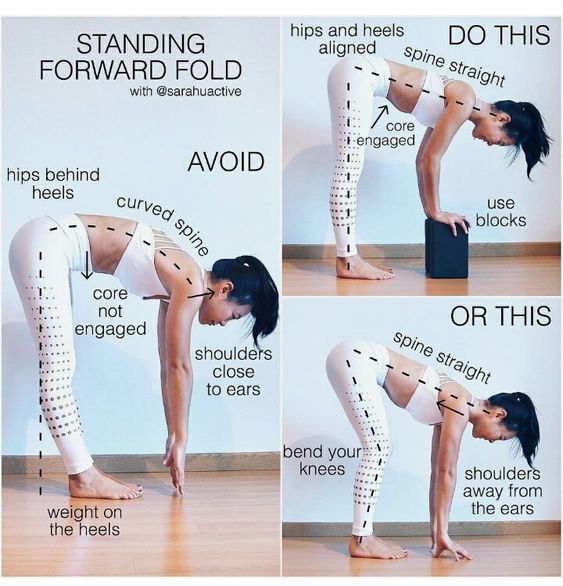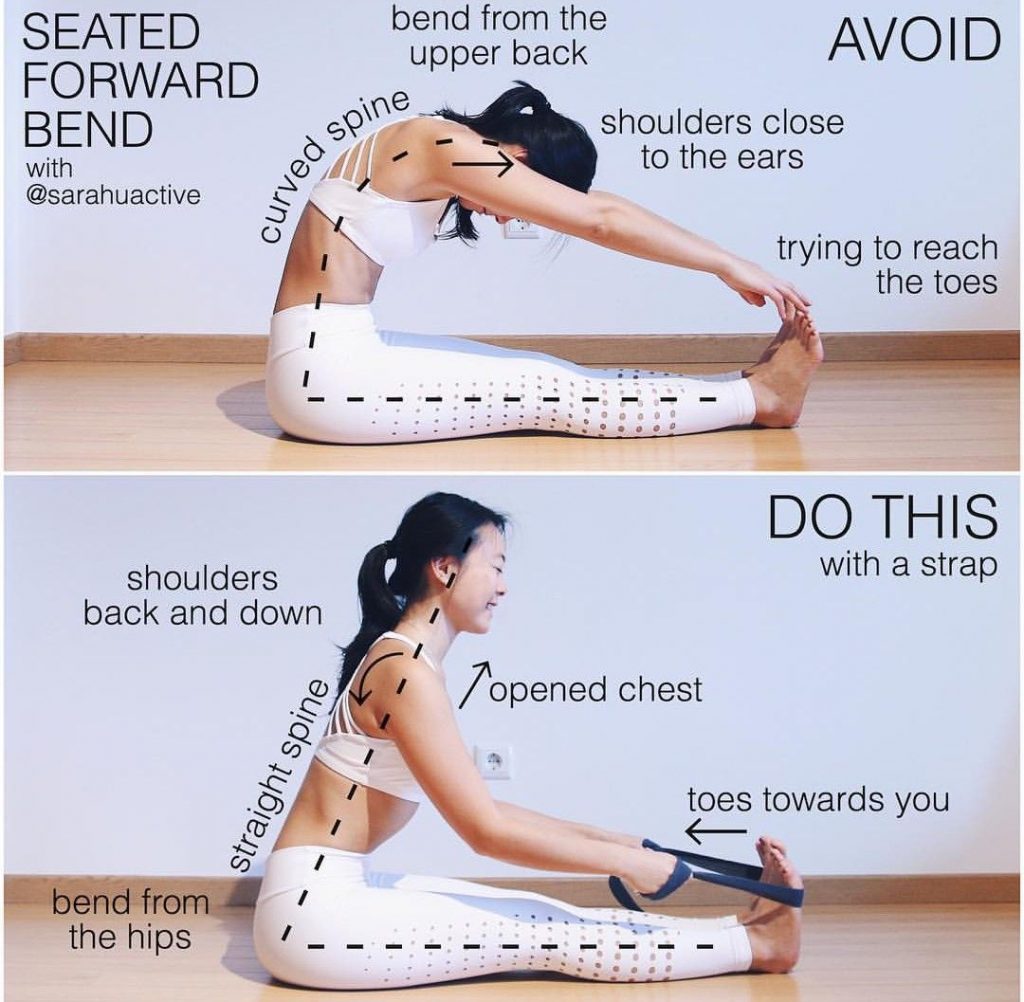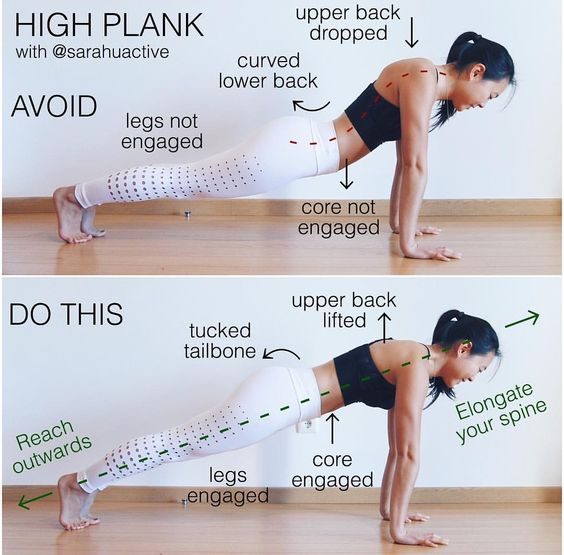Sometimes a yoga pose can feel wrong or even risky. And most of the time you are not wrong! Many yoga poses – even those for beginners – have the potential to cause pain and even injury.
In this article, we discuss 14 potential Yoga pose mistakes and how to correct them using proper alignment, modifications and different kinds of props. We back this up with some detailed images and descriptions so that you know exactly what we are talking about.
Based on this information, you should be able avoid many of the common yoga mistakes!
1. Mountain Pose (Tadasana)
Mountain pose is the foundation for all standing poses. One of the most essential Yoga poses, it helps us develop an awareness of our bodies, and improve posture, stability and confidence.
Common Mistakes: The legs and the core are not engaged, the upper body slouches and the head tilts forward.
Solution:
- Tuck the tailbone slightly under
- Lift kneecaps to tighten leg muscles
- Draw the belly towards the spine and engage the core
- Relax the shoulders and let hands hang loosely by side, facing forward
- The neck is straight and the chin is parallel with the floor. Imagine an invisible string lifting the head from its crown.
2. Tree Pose (Vriksasana)
View this post on Instagram
The tree pose is a common Yoga pose to strengthen feet and legs and create better balance, grounding and self-confidence. However, get this wrong and you miss out on the benefits.
Common Mistakes: The foot is placed on the knee, causing it to be pushed out. Also, if the hip juts, it is difficult to retain balance.
Solution:
- Place the foot either on the ankle, calf or upper inner thighs – but avoid the knee
- Keep both hips square and aligned
- Stand next to a wall, table or chair to hold on to if necessary.
3. Hero Pose (Virasana)

Hero pose is a very common pose at the beginning and end of Yoga practice, supporting both relaxation and meditation. In addition, Hero pose provides a deep stretch for knees, ankles and feet, assisted by the bodyweight that rests on the heels.
Common Mistakes: For anyone with issues around the knees, ankles and feet, hero pose without adequate care or support can be risky and painful.
Solution: Make sure you are adequately prepared for hero pose by either using props or omitting the pose altogether:
- for sore knees, place a blanket or shallow pillow behind the knees, or support your bottom on a block or yoga bolster
- if you have sore ankles and feet, place a blanket or shallow pillow under your ankle joints
- if neither prop works for you, take a break in a seated position.
4. Child’s Pose (Balasana)
Child’s pose helps stretch the hips, thighs, knees and ankles while reducing stress and fatigue. Besides, it is one of the common Yoga poses used to relax and rest during and after Yoga practice.
Common Mistakes: As with hero pose, anyone with issues around knees, ankles and feet can experience overstretching and pain in child’s pose.
Solution:
- If you have no props, only perform child’s pose as far as you can manage, keeping your bottom as far in the “air” as necessary
- For sore knees, place a blanket or shallow pillow behind the knees, or rest your bottom/body on a block or yoga bolster
- If you have sore ankles and feet, place a blanket or shallow pillow under your ankle joints.
5. Standing or Seated Forward Bend (Uttasana, Paschimottanasana)


Forward bends, whether standing or seated, are a great way to strengthen the core and leg muscles. Likewise, they deeply stretch the hamstrings and calves.
Standing forward bends also are an effective inversion, allowing body fluids to reverse their flow. This has an invigorating effect.
In contrast, seated forward bends are more relaxing and place less stress on the lower back than in standing forward bends.
Common Mistake: People with tight hamstrings tend to bend their lower back rather than their hip joints. Unfortunately, this can easily lead to injuries of the lower back.
Without a doubt, this is one of the most common Yoga injuries.
Solution:
- People with limited hamstring flexibility and Yoga beginners should keep their knees bent throughout the pose
- Engage the core and leg muscles when coming out of a forward bend
- Place hands on a chair or block to place the hands in standing forward bend to slowly ease into the pose
- Use a belt in a seated forward bend
- With practice and increasing hamstring flexibility, allow the legs to become straighter.
6. Chair Pose (Utkatasana)
Chair pose is one of the best poses to strengthen your legs and gaining greater confidence and mobility.
Common Mistakes: The knees extend over toes, placing pressure on the knees. Further, the arms may be raised too high, causing tightness in the shoulder and neck, as well as the lower back.
Solution:
- The tail bone is tucked in and the core is engaged
- Knees are bent at an angle that allows toes to remain visible from the top
- Keep arms extended up to a comfortable level while keeping the shoulders and the neck relaxed.
7. Downward Facing Dog (Adho Mukha Svanasana)
Downward facing dog gives an incredible stretch from the feet up to the hips. Equally, it stretches the upper body including the upper back, shoulder blades and arms, and right down to the wrists and hands.
At the same time, down dog engages the front of the thighs, the core as well as shoulders and arms.
As an inversion, it increases circulation, especially to the brain. In this way, downward dog rejuvenates and strengthens the whole body.
Common Mistakes: A common downward dog mistake is that most of the weight rests on the wrists, placing a strain on them. Often, the lower back bends downwards and the legs are kept straight, putting pressure on the lower back. Also, the thighs and the core are not engaged.
Solution:
- Bend knees and keep heels off the floor, unless your hamstrings are very flexible
- Engage the core and raise sitting bone as high as you can
- Keep the back straight and long
- Shift the weight from the wrists to the fingers and pads of the hands – fingers are widespread
- Roll shoulders outwards to open the chest.
8. Warrior II Pose (Virabhadrasana II)
Warrior II pose is a wonderful pose that engages the whole body. Not only that, it builds leg strength, opens the hips and expands the chest. The pose forms a stable base to help students connect with the earth, and cultivate balance, strength and mobility.
Common Mistakes: The stance is too short and most of the weight is on the front leg. Often, the front leg extends beyond the toes, thereby putting pressure on the knees. In addition, the knee may drop in instead of being well aligned with the extended arms.
Solution:
- Engage the back leg fully, keeping the back foot parallel with the end of the mat
- Place the knee of the front leg over the ankle
- Extend the arms straight on both sides and in parallel with the mat
- Open the chest.
9. Triangle Pose
View this post on Instagram
The Triangle pose is a balancing pose that tones the abdominal organs, the diaphragm and the spinal nerves. Equally, it strengthens the front of the legs and feet, while stretching the back of the legs, groins, hips, shoulders, chest and spine.
Common Mistakes: Bending sideways using the lower back, instead of bending from the hips. In addition, the head may droop downwards rather than being aligned with the spine.
Solution:
- Keep both legs straight and engaged – each knee is well aligned with the corresponding foot
- Bend from the hip to one side, while keeping a straight line through the side, neck and head
- Roll shoulders out and extend both arms straight and long
- Use a block or other prop if your hamstrings are tight.
10. Plank Pose (Phalakasana)

Plank pose is one of those love-hate poses because it is tough. However, it is one of the best poses to strengthen the arms, wrists, and spine, and for toning the abdomen
Common Mistakes: The core is not sufficiently engaged. Consequently the body drops down and puts pressure on the spine. Further, the head is bent back or forward – straining the neck.
Solution:
- Engage the core and keep a strong line from the bottom of the legs right through the neck
- Spread the weight evenly onto fingers and palms rather than the wrists only
- If the pose is too difficult, do a plank against a wall first, following the same guidelines.
11. Bridge Pose (Setu Bandha Sarvangasana)
Bridge pose is a great way to ease into a backward bend. The pose is both restorative and strengthening for the upper legs, buttocks and the spine. Also, it opens the thoracic spine, the chest and the heart. It also brings a fresh supply of blood to the pineal, pituitary and thyroid glands.
Common Mistakes: Common mistakes in bridge pose can happen if the legs are not well aligned with the feet, putting pressure onto the knees. The chest is not lifted sufficiently. People with current neck or shoulder issues go beyond what is beneficial.
Solution:
- keep legs are hip-width apart and well aligned with the rest of the body (use a block between the thighs to assist this)
- lift gently from the chest to the hips as far as the neck and shoulders permit without pain
- for beginners, keep hands next to the body rather than clasped behind the back
- use a block or pillow below the hips if the pose is difficult
12. Cobra Pose (Bhujangasana)
View this post on Instagram
Cobra pose is a gentle backbend that has many benefits, including stretching muscles in the shoulders, chest and abdominals, strengthening the spine, arms, shoulders and buttocks and increasing spinal flexibility. It also invigorates the heart and tones abdominal organs.
Common Mistakes: The hands extend beyond the shoulders, exerting pressure on the lower back. Also, going straight to high Cobra instead of low Cobra may affect people with lower back issues. Often, Toes are tucked in instead of lying flat on the ground.
Solution:
- Place hands right below the shoulders, with elbows parallel to the body
- Toes, knees and hips remain on the floor
- Hands gently press the boy upward initially to a low cobra and without putting pressure on the lower back.
13. Upward Facing Dog Pose (Urdhva Mukha Shvanasana)
Inherently, the pose has many benefits, such as stretching the front of the spine and strengthening the back of the spine. Besides, it stretches the chest and lungs, shoulders and abdomen.
Common Mistakes: Legs and knees remain on the ground and/or the arms collapse into the wrists. As a result, the lower back overarches.
Solution:
- The arms are strong and long and the shoulder blades pull together
- The knees and thighs lift off the floor
- Feet press into the floor
- People with sensitive backs are better off with a low Cobra pose (see Cobra pose above). By starting slow in this fashion, we can over time continue to slowly experiment with a high Cobra and then Upward Facing Dog pose.
14. Seated Twist (Marichyasana III)
The Seated Twist improves the flexibility of the spine and boosts blood flow to the spinal disks. At the same time, it strengthens the spine, as well as strengthens and tones internal organs by alternately compressing and stretching them. In doing so, it stimulates digestion and elimination.
Common Mistake: The supporting hand is removed from the body and back is rounded. In addition, the core may not be engaged properly.
Solution:
- Sit as straight up as possible, with supporting hand placed right next to the hip of the bent leg
- Engage the core and the extended leg and make sure the toes facing backwards
- Which each breath, attempt to elongate the spine while gently twisting.
Related Questions
How common are yoga injuries?
Yoga injuries are relatively common and growing in frequency, especially among older students. Surprisingly, even common Yoga poses that are generally regarded as suitable for beginners can cause pains and strains.
Knowledge about the correct alignment of different Yoga poses is critical for any beginner. It’s easy to get this wrong when Yoga poses are not learned properly from the beginning, or if any pre-existing health conditions get in the way.
Therefore, achieving proper Yoga alignment and paying attention to what can go wrong is key to avoid the most common Yoga pose mistakes and related injuries.
Another thing to keep in mind is that you can use a range of different “props” or aides to help you ease into Yoga positions that are too difficult at the outset. Understanding how these can support your Yoga alignment is therefore enormously helpful.
The benefits of correct alignment
Yoga, if done correctly, is extremely beneficial. Therefore, it is worth it to study the correct intention and alignment of the most common Yoga poses to achieve the maximum benefits.
By doing this, we avoid the most common Yoga pose mistakes and related injuries and disappointments. In turn we give ourselves the best chance to succeed and reap the benefits of Yoga.
Are you interested in finding out a bit more about the benefits Yoga in general? If so, check out our article Why Does Yoga Feel So Good? 10 Great Reminders.
How To Address Common Yoga Mistakes During Yoga Class
Once you have figured out which Yoga pose modifications apply to you, it’s a really good idea if you implement them in Yoga class as well.
Have a chat to your Yoga teacher about what your plans are and what props, if any, you plan on using.
Image Sources
- @yogabykarina – yogabykarina
- @sashiguptayoga – guptayoga
- Taylor Pangman on Youtube
- YogabyCandace.com
- @sarahuactive – sarahuactive
- @roxannegan – roxanneyoga
- @actionjacquelin – actionjacquelyn
